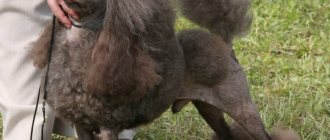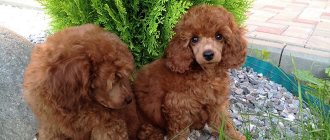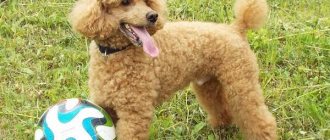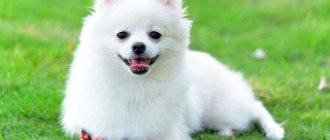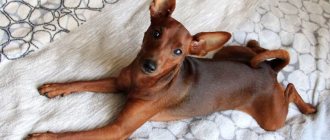Story
There are different opinions about the appearance of the Toy Poodle breed. Most breed researchers are confident that micro dogs were bred in France.
But some consider their homeland to be Germany, since the word “poodle” - pudelhaas - is of German origin. Translated, it sounds like “throughly wet.” This reflects the original purpose of the pets, which delivered killed game from the water to hunters.
The second part of the name “toy” comes from the English Toy (toy). Indicates that the dog belongs to the smallest variety of poodles. According to the description, pets are below 28 cm at the withers.
Clubs for breeding shaggy mini dogs appeared in the 19th century. The original breed standards were developed in England. Their publication dates back to 1886. At the same time, poodles began to appear in Russia, where the breed quickly gained recognition. Dogs become pets and are valued among the intelligentsia. The official breed standard, authored by French breeders, was developed and adopted in 1936.
History of appearance
The poodle breed is considered very ancient.
Even now, the history of its origin is controversial. There is an assumption that it was Central Asia that became the birthplace of shaggy herding dogs. It was from there that these dogs spread throughout Europe. This happened during the process of moving herds, when animals were used as helpers. They also escorted caravans of merchants to their destination. Archaeologists have discovered coins dating back to the 30s. BC, which depicted a dog resembling a modern poodle.
By the 16th century, several breeds already existed, united by one common name: poodle.
These breeds were bred by the French and had completely different purposes. Large poodles were used mainly for hunting, while medium ones searched for truffles. Small poodles were an invariable attribute of high society ladies who were accompanied everywhere.
White poodles were immediately selected for hunting. This color was clearly visible at long distances.
It is likely that the name “caniche”, that is, poodle, comes from the French word “cane”, which literally translates as duck.
The poodle dog was originally used only for hunting birds whose habitat was water.
There is also an interesting expression in German: “pudel-nass”. It translates as soaked to the skin. In Germany, the main purpose of dogs with long hair, similar to the modern poodle, was to pull out shot game that had fallen into the water.
All these specific names of the breed indicate that among the ancestors of the poodle there were so-called water dogs.
The debate about whether France or Germany is the birthplace of poodles is still ongoing.
Nobody knows for sure who the direct ancestor of the miniature poodle is. And this breed most likely appeared due to the fashion for small lap dogs. Experiments led to the fact that toy poodles, animals even smaller in size than dwarf ones, also saw the light.
When experimenting with the breed, breeders always paid attention to the preservation of the basic instincts of a hunting dog, such as a good scent, mobility and flexibility. And most importantly - the amazing fur that remained intact.
The first exhibitions at which poodle dogs were presented took place at the end of the 19th century.
The breed has attracted attention. It was brought to Russia by Russian aristocrats who often visited France. Unfortunately, the 1917 revolution destroyed almost all dogs of this breed. The remaining individuals began to interbreed with other dogs. The purity of the breed in Russia was lost.
Poodles came back to our country only in the 60s of the 20th century. Slowly but surely the dog population began to grow. In cities such as Moscow and St. Petersburg, nurseries appeared that began to specialize in breeding dwarf poodles.
Description
Despite their miniature size, toy poodles exhibit harmonious proportions. When assessing a breed, the main parameters noted by the standard are checked. Dogs with symptoms of deformation changes in the bone structure are not used for breeding.
Main characteristics of the breed description:
| An object | Peculiarities |
| Head | The configuration is correct, the forehead is convex, oblong, of medium width. Cheekbones and cheeks are flattened. Prominent eye arches do not weigh down the muzzle |
| Nose | Looks flat from above. When viewed from the side it has a rectangular shape. The lobe with neat open nostrils is highlighted in black or in color to match the color |
| Jaws | Quite strong with small teeth forming a scissor bite. The adjacent thick lips are pigmented |
| Eyes | Clear, almond-shaped, shiny with densely colored eyelids |
| Ears | Elongated, rectangular in shape with rounded ends. Hanging, close to the head |
| Neck | With a slightly convex scruff, strong |
| Frame | Thanks to the straight short back, muscular lower back, rounded croup, oval chest, it is proportional |
| Tail | Set on high, docked by a third or half if necessary. When at rest it is lowered, when moving it rises obliquely upward |
| Limbs | With strong joints, smooth. The thighs are muscular, the knees are angled. Claw pads are pigmented |
Features of caring for poodles
Poodles require careful grooming. You can do without a model haircut, but it is better to do a hygienic haircut once a month along with bathing. You should brush your dog every day. Don’t forget about such simple elements of dog hygiene as cleaning ears and teeth.
A little about the haircut. For this breed it is one of the most difficult. Special types of haircuts, such as "lion", "English saddle", "puppy" or "sport" are done by a special hairdresser. You can do simple hygiene yourself using a machine.
Varieties of colors
A distinctive feature of the toy poodle is its abundant coat. The dog's guard hair is fluffy and thin. The structure is elastic, well curled.
The colors are more often monochromatic:
- grey;
- chocolate or brown;
- black;
- red or red;
- apricot or peach.
The dog's elastic skin with a white coat has a silver tint. In other cases it corresponds to the main color of the breed.
Several exhibition haircuts for the poodle have been developed, permitted by the standard: “Modern”, “Lion”, “English”.
Characteristics and standard of the poodle breed
The characteristics of the breed are very interesting. The poodle breed standard is the same for all dogs, regardless of size and color.
The Standard Poodle should be slender and fit. It has wavy or curly and very thick fur. The gait is sliding, elastic.
The Poodle breed has a small head. The muzzle occupies 9/10 of the skull, regardless of the species. The color of the nose varies depending on the color of the animal: black in black, white and gray; brown for redheads; colored in peach or apricot (can vary from black to dark brown).
The eyes are shiny and located at the height of the frontal curve. The color is usually black, but in browns it can be amber. Proud look. The ears are long and hang down along the muzzle.
Shoulders are muscular. The length of the humerus should correspond to the length of the shoulder blade. In this case, the angle between them should be 90–110 degrees. The chest should not be massive, its end protrudes slightly. The back is short and straight. Limbs parallel to each other.
The Pointer Poodle is not subject to all of the above criteria. Outwardly, it is difficult to say that the poodle participated in the creation of this animal. The Pointer Poodle lacks the grace that is present in its relatives. Only their muzzle is somewhat similar. The Poodle Pointer is a large dog that can weigh 30 kg.
Behavior and skills
Graceful toy poodles have an innate nobility and aristocratic habits. Dogs quickly get used to a new place. With properly organized training, poodles acquire the necessary skills.
Small pets become children's best friends and are great at sensing the mood of the rest of the family. Dogs join in the game willingly and with pleasure, but cannot tolerate excessive intrusiveness.
With such a cheerful ringleader, there will be no silence in the house. The pet not only plays noisily, pokes its curious nose into all the cabinets, but also barks loudly and loudly for any reason.
It must be taken into account that hunting instincts are in the blood of dogs of this breed, therefore, when raising a pet, all attempts to display aggression are suppressed. This allows you to raise friendly, loyal companions who are tolerant of guests and get along with other pets.
Active and inquisitive pets always find something to do indoors, but don’t forget to take your dog for a walk at least twice a day. If possible, pets are allowed to swim. On the street, dogs are rather indifferent to other dogs and do not try to come into contact with them.
Character
Poodles are distinguished by their sharp intelligence and devotion to their owner. These are active, obsequious and cheerful animals. Poodles love to fool around and play outdoor games. It is believed that females are smarter than males and are preferable as companions. They are affectionate and sensitive, adore their owners. In addition, they pick up any commands on the fly and are easily toilet trained. Males have a more impressive appearance and are prone to aggression, so increased attention is paid to their training.
With proper upbringing, the poodle and children turn into best friends. Some dogs prefer to interact with teenagers. It can be difficult for a child under the age of 12 to train a poodle. The pet will try to outwit him and benefit from it.
This breed requires special attention. People who work a lot should choose another dog. If a poodle is not interacted with enough, it becomes withdrawn and aggressive.
Poodles are not prone to zoo aggression. They get along well with cats and other dogs because they prefer to communicate with their owner. But there are examples of their tender affection for animals.
This breed is artistic and loves to be the center of attention. In addition, large poodles can be raised to be full-fledged defenders. They have developed bodyguard instincts and will be able to repel an attacker. Even miniature representatives of the species will greet a stranger with a piercing bark. Poodles will reciprocate their love for a loving owner and will be devoted to him until the end of their lives.
Character and appearance of the toy poodle
Toy poodles genetically have high intellectual abilities. With unconditional attachment to people, pets require care and constant attention. Knowing these characteristics of the breed, they leave the dog alone only for a short time.
The character of the breed is characterized by restraint and intelligence. Given these qualities, elegant, energetic dogs are often used in the circus and artistic fields. You can teach your pets to perform simple tricks at home.
Sometimes dogs can be wayward and stubborn. In such cases, it is necessary to act strictly with pets, but without cruelty.
The external characteristics of the breed are based on the ratio of weight (2-2.5 kg) and height (24-28 cm). Such miniature dimensions of an adult dog do not exclude harmony in the composition of the entire body, which looks organic. The dog's movements are springy and graceful.
Types - brief description of the breed
Poodles are varied in appearance, color and coat type. The ICF recognizes the following sizes:
- standard/large: height from 45 to 60 cm;
- small: height from 35 to 45 cm;
- miniature/dwarf: height from 28 to 35 cm;
- toy poodle: height less than 28 cm.
The small species has a second name - medium poodle. The breed is also divided into varieties based on coat type: curly and corded.
Acceptable colors include:
- white;
- black;
- brown;
- apricot;
- silver;
- red;
- harlequin and tan (only in Russia).
The red color of the coat was not recognized by FCI members for a long time. In 2007, lovers of the fiery color achieved its registration.
The Poodle is a decorative dog with a lean build, the main feature of which is its lush, curly coat. General breed standard:
- Size: height from 28 to 60 cm, weight from 7.5 to 12 kg.
- The head has an elongated shape, the muzzle is narrow at the end. The occipital protuberance is well defined.
- The shape of the eyes is almond-shaped, the color of the iris is dark brown. Red, brown and apricot poodles have brown irises with splashes of amber. The corners of the eyelids are pigmented.
- The bridge of the nose is straight. The color of the lobe depends on the type of color: in white and black poodles it is colored black, in brown poodles it is colored coffee. Apricot and red colors produce black or brown color. A light colored nose is called a winter nose and is undesirable.
- The ears are low set, hanging, long with rounded ends. Fits well to the head. Their length reaches the lips.
- The neck is dry, moderately long, with pronounced muscles.
- The scruff of the neck is pronounced, the withers – weakly.
- The back is strong, rather short, and has a slight slope towards the croup.
- The belly is slender, toned, with an elegant curve.
- The tail is high set and straight. According to the standard, the tail should be docked by two-thirds.
- The forelimbs are positioned at a slight angle. They are strong and muscular.
The described traits should be present in all varieties of poodles, regardless of size or color. This breed is also characterized by dense pigmented skin. In dark-colored dogs, the pigmentation should match the coat color (primary).
Toy poodle
The toy poodle is a very popular decorative pet. Its pocket format does not affect mental abilities: this baby is easy to train. Its ancestors include the Sheep Poodle and the Spanish Water Dog. Any solid color is allowed, but preference is given to pure shades.
This variety is very difficult to maintain. Poorly trained dogs are prone to aggression, especially towards children. They also belong to the category of empty nesters, which means they can burst into loud barking at any moment.
Toy poodles require regular financial investments. They need a model haircut, clothes and quality food. In addition, they are suitable only for active owners.
One of the main disadvantages of the breed is its tendency to serious genetic diseases. Toys do not need contact with their relatives: they are human-oriented.
Miniature Poodle
The mini poodle has a phenomenal ability to train. It is often used in circus performances. This dog loves to do tricks. Sometimes owners think that their pet understands their speech. His coat is colored standard for the breed.
Mini poodles are true introverts. They don't like interacting with dogs or strangers. Dogs prefer to communicate only with the family in which they live. At the same time, they are not prone to aggression and can happily meet friends. These kids are very jealous: they do not like it when the owner shows sympathy for another animal. Toy poodles love attention and try to get it in a variety of ways.
Royal Poodle
Royal (same as large or standard) is the largest representative of the breed. Its long, curly coat can be rolled into cords or trimmed. Poodles are able to remember a command after three repetitions. Their high level of intelligence allows them to manipulate children and owners.
It is not recommended to trust small children (under 12 years old) to train a dog: the poodle will outwit the child.
Cocker Poodle (Cockapoo)
The Cocker Poodle is a cross between a Cocker Spaniel and a Poodle. It was developed in the 30s of the 20th century in the USA. Breeders wanted to get a poodle hybrid free from genetic abnormalities. The experiment turned out to be successful. Cockapoos grow up to 38 cm and weigh up to 15 kg. The coat is soft, with a wavy structure, reminiscent of the pile of spaniels. The color palette is very diverse: dogs can be red, red and white, black, white, cream, brown.
Cockapoos are attached to humans and have difficulty with separation. In general, the Cocker Poodle is indifferent to its relatives, but cases of the most sincere friendship are known. He does not show aggression towards children, but will not forgive them for careless treatment.
Cocker poodles are sensitive to their owner's mood. It is enough to slightly change the intonation for the dog to understand whether he is being praised or scolded. This breed is prone to barking for no reason. Some of its representatives can be nervous and jealous.
Breeding
The desire to acquire a pair of toy poodles for the purpose of further reproduction should be based on knowledge of the characteristics of this breed.
Puberty of pets occurs at the age of 6 to 8 months. At this stage, it is not recommended to start mating dogs, so as not to cause negative consequences for the female.
For breeding animals that must be healthy, the first mating is carried out when they are 1.6 to 1.8 years old. The dog's territory is used to meet dogs. During pregnancy, which lasts on average from 58 to 66 days, the bitch is under special control. A veterinarian is called for the birth.
For the first month, the toy poodle puppies are cared for by the female. Already at two weeks of age, they begin to crawl, hear and see well. Then the owner will need to regularly examine the babies, wiping their eyes and ears if necessary.
How to choose a puppy
The choice of poodle puppies is quite wide, due to the differences in their color and size. It is worth considering that you should not take a miniature (dwarf) or toy poodle into a family with a baby, since dogs from this category often suffer from childhood awkwardness. The choice of color depends on subjective preferences. One litter can have poodles of different colors.
Poodle grooming
During a visit to a breeder, in whose reputation you, of course, should be confident, do not rush to immediately purchase the first puppy you like, but observe its behavior. Healthy poodle puppies are always active and playful, and among them you need to choose the most active and curious one. Please note that females are generally calmer.
If you decide to opt for a miniature or toy poodle puppy, do not buy the smallest one: it may also be the weakest.
Check the poodle's eyes - they should be clean, without accumulation of secretions in the corners. It is also necessary to examine the tummy for rashes and redness. Do not neglect to check the condition of the hair under the tail: if it is stuck together, it is likely that the dog has digestive problems. The dog should not itch or limp.
Even purebred white poodles may have cream or apricot areas of fur on the chest, ears, and lower limbs - this is not a defect of the breed; with age, the fur will turn white. It happens that puppies are born with pink noses and paw pads, but over time these areas darken.
It is preferable to purchase poodle puppies when they are already 2 months old. If you want your chosen one to take part in exhibitions in the future, he must be at least four months old.
The breeder must give you a puppy card, which can then be exchanged for a pedigree, and a veterinary passport with vaccination records.
Photos of poodle puppies
Education and training
Pets begin to be socialized from an early age. Puppies are taught to go to the toilet in a designated place and rest on a bed. Gradually, the dog is helped to master the collar and leash and is introduced to a variety of sounds.
Expert opinion
Anna Abramenko
An avid dog lover. Experience in veterinary medicine since 2009.
Ask a Question
At the first stage of raising a pet, situations that could frighten the puppy are excluded. All training actions are accompanied by soothing words and stroking the dog.
On walks, the grown toy poodle explores the territory. With proper preliminary preparation, the dog will not be afraid when he sees cars, other dogs, or a lot of people.
Smart dogs of this breed quickly remember commands. They are happy to do them if the owner is patient and follows a logical sequence when training the dog. The atmosphere should be calm, the intonation should be strict, but without shouting or threatening notes towards the pet.
Owner reviews
“I first saw this breed at the circus and was amazed at how smart and capable of learning these dogs are.
Since the beginning of the 90s, more than one generation of poodles has lived in our family. They are the perfect companions! They willingly accompany us on walks and at the same time, they don’t mind lying on the sofa. They express emotions very sincerely and are focused on communicating with people.”
Eva Lanskaya, small poodle breeder.
“I first got a black royal poodle, it was my parents’ dog, but personally I always wanted a medium-sized dog. Therefore, when the opportunity arose to acquire a new family member, the choice fell on a small variety of the breed.
According to my observations, apricot-colored poodles are the most active and impulsive. But from Harlequins you can expect the warmest manifestations of feelings and gentleness.”
Marina Guchina, owner of the small poodle breed.
Care and maintenance of a toy poodle
Toy poodles are valued for their compact size. They feel great in small apartments. When following the recommended hygiene procedures, pets remain active for a long time.
The dog’s luxurious coat requires the main attention. She is brushed daily, even with short hair. Dogs are given baths on average every 7 weeks. After returning from the street, be sure to wash the pet’s paws and wipe the dog’s body to remove any minor dirt with a damp cloth.
The care and maintenance of a poodle includes regular updating of the show hairstyle. To do this, go to a specialized salon once every 2 months.
In cold seasons, the dog is given clothing for walking, which will help prevent the dog from becoming hypothermic. In heavy rain or frost outside, a toilet-trained pet remains at home.
Among the hygiene procedures for a poodle, brushing of teeth (daily) and ears (once a week) is practiced. The dog's nails are trimmed if they have time to grow back within a month's interval. The pet's eyes are examined and wiped regularly.
Video “How to trim a toy poodle”
In this video, a specialist will show you how to properly cut a miniature poodle's haircut.
Similar article: History of the origin of the breed and description of the poodle
Recommended Posts
Standard height and weight of the Cane Corso breed by month
Weight of a puppy and an adult Labrador by month
Weight and height of a German Shepherd puppy by month
38 best dog breeds for apartments according to reviews from breeders and owners
Description and content of the hunting border terrier
Review of the 12 most unpretentious and obedient dog breeds
Dog food
When choosing a diet for a poodle, they are guided by the type of food to which the puppy was accustomed to by the breeder. This will help avoid problems with your pet's adaptation.
The most convenient option for a dog is to use ready-made balanced dry or wet food complexes. Be sure to study the instructions, which indicate the types of dogs for which they are produced. The recommended daily dosage is observed when feeding a toy poodle. The dog must always have access to clean water.
When compiling a natural menu, the pet is given lean boiled meat every day, which makes up half of the diet - turkey, chicken, beef. To provide the dog's body with useful elements, add rice porridge, oatmeal, buckwheat, lightly flavored with vegetable oil.
Vegetables are introduced into the dog’s diet, except legumes and potatoes. Twice a week, the dog is given boiled sea fish instead of meat. Enrich the poodle’s nutrition with vitamin and mineral complexes after consultation with a veterinarian. Bananas or apples are used as treats to encourage your pet. The dog is allowed an egg every 4 days.
Expert opinion
Anna Abramenko
An avid dog lover. Experience in veterinary medicine since 2009.
Ask a Question
Puppies are given food in small portions up to 5 times a day. Adult dogs are fed morning and evening.
Feeding
Feeding a miniature poodle is no different from feeding any other breed. You just have to decide on its type. If you prefer dry food, you must definitely choose food of at least a premium class.
When feeding naturally, you need to think about your pet’s diet. The main component should be meat. A couple of times a week you can replace meat with sea fish. Be sure to add porridge, fruits and vegetables, fermented milk products and eggs, and vegetable oil.
Fatty foods should be excluded from your pet's diet.
The sensitive liver of a poodle will definitely react not in the best way to imbalances in nutrition.
It is necessary to strictly control the dog's portion without overfeeding it. This applies to any type of feeding.
It is under no circumstances recommended to mix dry food and natural products.
Health and illness
Miniature poodles, when treated with care, make their owner feel good. It is recommended to follow all preventive measures prescribed to your dog by a veterinarian. You should not violate your pet's vaccination schedule.
The following advice is related to the breed’s predisposition to a wide range of pathologies:
- Urolithiasis disease. A long course of treatment for the dog is required.
- Alopecia. The appearance of bald spots on the outer parts of the pet's ears. The necessary medications are selected for the dog after the cause has been established.
- Tonsillitis. Drug therapy using antibiotics is carried out.
- Pancreatic atrophy. The consequence is the development of diabetes in the dog.
- Eclampsia. It occurs during the postpartum period against the background of calcium deficiency in the body, so veterinarians prescribe medications to the poodle that increase the concentration level of the missing element.
- Non-closure of the ductus Botallova. This congenital defect provokes growth retardation and shortness of breath. According to indications, surgical intervention is required.
- Microphthalmia. Genetically determined underdevelopment of the eyeball, often accompanied by eversion of the eyelids.
- Dislocation of the kneecaps. To eliminate lameness, the dog is prescribed surgery.
- Epilepsy. In order to ensure the life of the pet, compliance with the regime and constant monitoring is necessary.
- Cataract. This pathological change in the structure of the lens is more common in adult dogs. Pathology in cases of threatened blindness is treated surgically.
- Von Willebrand's disease. Characterized by decreased blood clotting. The pet is prescribed a specific group of medications.
Toy poodles that are quickly excited sometimes develop neuroses. If you notice a rash on the skin or your pet trying to bite its fur, you should consult a veterinarian about treatment. Some representatives of the breed have a congenital tendency to deafness.
Expert opinion
Anna Abramenko
An avid dog lover. Experience in veterinary medicine since 2009.
Ask a Question
To prevent the dog from developing tartar, the development of ulcerative stomatitis, and gingivitis, maintain hygiene and regularly visit a specialized clinic.
Health
The life expectancy of miniature Poodles reaches 15 years, although with good heredity and quality of care, this figure is not the maximum. Unfortunately, all representatives of the breed, regardless of size, are prone to a fairly wide range of ailments:
- Hip dysplasia - manifests itself in old age.
- Pinched spinal nerves due to deformed spinal discs are usually the result of improper alignment, injury, or other musculoskeletal problems. In severe form, it can lead to paralysis.
- Cataracts , increased intraocular pressure ( glaucoma ), and retinal degeneration are hereditary ailments that can appear at any age.
- Age-related osteochondrosis – bone fragility.
- Lymphadenitis is an enlargement of the lymph nodes due to overexcitation of the immune system.
- Hypothyroidism is a disorder of hormonal metabolism due to improper functioning of the thyroid gland. Most often it is expressed by a lack of hormones, which leads to lethargy, weight gain, problems with the skin and digestion of food.
- Diabetes mellitus is a violation of the process of glucose utilization due to a lack (improper production) of insulin.
- Insulinoma is a benign or malignant tumor that occurs when hormonal metabolism is disrupted.
- Von Willebrand's disease - leads to sudden bleeding from the mucous membranes, including internal ones.
- Food allergy is a reaction of rejection caused by a specific product. It is expressed by itching, irritation of the mucous membranes, lacrimation, profuse nasal discharge, hair loss, and dermatitis.
- Hair loss - from allergies or other reasons.
- Otitis – the ears adjacent to the head create ideal conditions for the proliferation of pathogenic bacteria in the auricle. Primary symptoms are attempts to scratch inside the ear, frequent shaking of the head, a sharp reaction to pressure in the ear area (pain).
- Urolithiasis is an age-related problem, especially if the dog eats low-quality dry food.
- Congenital deafness is a hereditary disease that leads to irreversible degeneration of the cochlea.
- Intestinal volvulus is an acute, life-threatening condition that occurs when a fragment of an organ physically overlaps.
- Degenerative myelopathy is a neurological disorder that results in the deterioration or cessation of the transmission of nerve impulses responsible for muscle control. The dog falls on its hind legs or walks unsteadily, tucking its wrists.
- Epilepsy is a neurological disorder that occurs as a result of injury or as an independent disease. Leads to unexpected attacks of seizures of varying severity and duration.
- Cryptorchidism is a defect that leads to incomplete descent of the testes into the scrotum in male dogs. The disease can be corrected surgically, but the dog is no longer allowed for breeding.
Lifespan
Toy poodles, despite their predisposition to many diseases, are surprising in their longevity.
If the owner follows the vaccination schedule and is attentive to the prevention of colds, the pet remains mobile and active.
Expert opinion
Anna Abramenko
An avid dog lover. Experience in veterinary medicine since 2009.
Ask a Question
Dogs with identified hereditary disorders in the body are not allowed for breeding. This allows you to get strong offspring.
On average, representatives of this breed live up to 18, and sometimes up to 20 years.
Content
You can keep a poodle both at home and outside the city. Thanks to the existence of several varieties of poodles, you can always choose a dog that you can keep. But, if you have a large family with children, then you definitely need to take a standard one, which, unlike small and miniature ones, can physically withstand all the tests of family life. One way or another, no matter which poodle you choose, remember - they are very sociable and cannot stand loneliness.
They love to swim and play with a ball. Poodles were the favorites of many famous writers, artists, and musicians.
Pros and cons of the breed
Owners of toy poodles note many advantages that emerge when interacting with these funny miniature animals:
- pet's balance;
- high intelligence of the poodle;
- dog's intelligence;
- excellent appearance of the breed;
- fast learning of the pet;
- the dog's loveliness;
- compact size of the breed;
- restraint towards strangers;
- hypoallergenic hair;
- almost invisible shedding.
Disadvantages of the breed:
- painstaking daily care of the pet;
- taking serious measures to prevent and, if necessary, treat various pathologies, most of which are hereditary;
- excessive noisiness of the pet, frequent loud barking.
Due to their expressed friendliness, toy poodles are not suitable for the role of guard.
Taken together, the pros and cons make up a complete list of the characteristics of the breed, knowledge of which helps in organizing the maintenance of amazingly graceful animals.
Dwarf
Toy poodles are charming and very sociable creatures. Due to their accelerated metabolism, they, like other medium-sized dogs, are characterized by increased activity and restlessness. They are almost constantly on the move and love to frolic and play in the fresh air.
Important! Miniature poodles make very good friends for older children, 10 years and older, but it is not recommended to buy them as a gift for children, as they may accidentally harm the pet.
As a rule, they treat other animals quite loyally, unless they themselves try to offend them.
Miniature poodles have a strong attachment to their owners; they love it when they pay more attention to them and are offended if for some reason this does not happen. If the owner is absent for a long time, for example, went on vacation or on a business trip, they may greatly miss him.
At the same time, if the pet has been properly raised and trained, it practically does not cause problems. An obedient disposition and a tendency to please their beloved owner, as well as goodwill and sociability, make such dogs ideal pets that are pleasant to keep in the house and with which you can walk down the street without any problems.
In general, the toy poodle is as smart, quick-witted, affectionate and loyal as other poodles.
List of nicknames
For an original mini-dog, choose a name that suits its appearance or character. It is necessary to avoid long words with a lot of consonants that sound rude. Pets are often called affectionately, tenderly, or with exotic intonations.
Common nicknames for male dogs: Arto, Arsen, Archie, Buckley, Basil, Barney, Waltz, Harry, Count, Dustin, Jazz, Zhulbert, Fuse, Zigmund, Zorik, Indigo, Lucky, Lel, Lawrence, Mike, Nils, Nord, Olaf , Orpheus, Austin, Paco, Pele, Peach, Rice, Sally, Tonic, Fidel, Elvis, Janek.
Names for females: Agata, Adele, Assol, Alisa, Alma, Amalia, Beata, Bella, Businka, Valerie, Vega, Viola, Gabi, Glasha, Denise, Diana, Dina, Dora, Eva, Giselle, Zara, Zizi, Zita, Toffee, Lada, Laura, Lucy, Nicole, Richie, Selina, Tori, Ulya, Utah.
MATING
Puberty of poodle males and females occurs at 6-8 months. However, it is not recommended to mate dogs at this age, since the growth of the body is not complete and the pregnancy of the bitch can adversely affect her health and offspring.
Breeding animals are usually mated at the age of 1.6 – 1.8 years. They must be absolutely healthy.
Selecting animals into pairs is the most crucial moment. The heredity of animals and the forecast of mating results are taken into account. The male must be qualitatively superior to the female. When mating with a male that is worse than a female, it is difficult to expect an improvement in the offspring. You should not select pairs of dogs with similar shortcomings (for example, weak constitution, poor sense of smell, etc.). For breeding poodles, you should contact specialist breeders.
The first mating must be done carefully. If a bitch mates for the first time, she usually growls and snaps. A young male dog may become afraid, and this fear will remain with him for a long time. It is better to bring a bitch to a dog, and not vice versa. At the time of mating, the male should be in a familiar environment. For the first mating, it is better for a young male to bring a calm, already mated bitch. On the day of mating, you need to feed him no earlier than 5-7 hours before the bitch arrives, then take him for a walk after mating, and only after 2-3 hours can he be fed again.
A pregnant bitch should be kept in a warm, dry, bright room, which should be periodically ventilated. It is necessary to prepare soft, dry and clean bedding for it. Usually mattresses are sewn together and stuffed with soft hay, oat straw or cotton wool. It is good to put covers on mattresses. For small and toy poodles, you can make a nest in a box, making one wall low.
It is covered with fabric so that the dog does not injure the nipples when entering and exiting the box. In the first half of pregnancy, caring for the bitch is normal, in the second half it is more thorough. She is walked on a leash, avoiding sudden movements and overwork, which can lead to miscarriage. It is better to refrain from bathing the bitch during this period. During pregnancy, many dog breeders give their bitches multivitamin tablets: large poodles - 1 tablet, small and medium - ½ tablet, miniature poodle - ¼ part once a day. It is useful to add trivitamin to food: large poodle – 8-10 drops, medium – 5-8 and dwarf – up to 5 drops daily.
A female's pregnancy lasts an average of 63 days (58-66 days). Before giving birth, she stops eating and looks for a place to nest. 1-2 weeks before whelping, the bitch should be washed with warm water and baby soap or shampoo and dried thoroughly, and on the eve of whelping, the long hair around the nipples and external genitalia should be trimmed. Childbirth usually lasts 5-18 hours. During this period, the bitch should not be disturbed. Females of a large poodle usually give birth to 2-4 puppies or more, small and dwarf puppies - more often 1-3. After whelping, the contaminated bedding must be removed, clean bedding must be laid, and it must be kept clean in the future.
A nursing bitch should be walked at least three times a day, initially for 5-10 minutes, gradually increasing the duration to 15-20 minutes. Every 4-5 days, the bitch’s nipples must be washed with warm water or a solution of boric acid, wiped dry and lubricated with Vaseline. After whelping, the bitch is not fed for the first 6 hours, and then given a little (up to 0.5 l) warm milk with glucose and up to 150 g of white crackers soaked in milk. There must be water constantly. For the next 3 days after giving birth, the bitch is given dietary liquid porridge (white crackers in milk, liquid meat soup with oatmeal or semolina, etc.), and then transferred to a regular diet. You can bathe a nursing bitch no earlier than 5-7 weeks after whelping.
Poodle puppies are born deaf, blind and without teeth. The first days they are helpless, but food reflexes are well developed. By the 15th day, puppies begin to see, hear and crawl, and on the 20-25th day, milk teeth erupt. During this period, they need to be kept in a specially equipped nest (box) so that the bitch cannot inadvertently crush them. Sunlight should only be reflected, since direct sunlight hitting blind puppies greatly irritates them.
Usually the mother cares for the puppies for the first month. Then the owner must do this. It is necessary to inspect them daily and wipe their faces with a towel after each feeding. Once a week, inspect the ears and clean the inner surface of the auricle with a cotton swab or bandage moistened with salicylic or boric alcohol. Long ear hair needs to be cut. You should examine your eyes every day and, if necessary, wipe them with a swab soaked in boric acid or tea. Once a week you need to brush your teeth with chalk, tooth powder or citric acid.
On the 3rd day after birth, as a rule, the tail of poodle puppies is docked at ½ - 1/3 of the length. It is advisable to have a specialist do this, although you can do this simple operation yourself. At the level of the second or third vertebra, the skin is treated with tincture of iodine, moved to the root of the tail, an incision is made in the skin and other tissues along the joint, the stump is cauterized with iodine for several minutes until the bleeding stops completely. It is better to put stitches on the skin at the end. You can apply an elastic band or bandage tightly in the indicated place. After 2-3 days, the tip of the tail dries out and falls off.
Poodle puppies begin to actively move and play from the age of three weeks. Therefore, it is necessary to practice exercise games with them to develop endurance and strength. For games you can use blunt bones, light objects, a ball, rattles, carrots, potatoes and more. The puppy loves to chew objects that come into view - shoes, rugs, furniture, etc. If the item cannot be hidden, then you can rub it with hot red pepper. After the first test, the puppy’s desire to chew disappears.
Rules for choosing puppies
When purchasing a toy terrier, you need to realize that it is almost impossible to independently determine the differences from other varieties of poodles. Therefore, you should contact proven breed nurseries.
It will offer babies aged from 2 to 2.5 months with completed vaccinations. They will issue a document confirming compliance with the breed standard.
Poodle puppies need to be examined. Dogs should have clean fur, shiny eyes, and no dirt in their ears. Pay attention to the children’s activity and behavior without aggression.
How much does a poodle cost?
The cost of a poodle puppy depends on its size, color, age and location of the kennel.
Show-class puppies with exhibition prospects are sold from 90,000 rubles. Breed-class babies who can take part in breeding are priced from 70,000 rubles. Poodles belonging to the pet class, which have minor deviations from the standard, but are completely healthy and beautiful, cost about 50,000 rubles. Poodles with coats that are rough to the touch, reminiscent of horsehair, are always rated lower.
Interesting facts about the breed
The portrait of the toy poodle is complemented by a variety of information that allows you to adequately evaluate the animals.
- In terms of mental abilities, poodles are in second place in the ranking, second only to border collies.
- These dogs are rightfully considered the best option for allergy sufferers.
- Having set a goal in training a toy poodle, you will be able to get a tireless assistant, a waterfowl hunter, in the process.
- The king of rock and roll, Elvis, valued poodles.
- In France, this breed is considered national pride. Dogs were included in the list of equipment of officers of the Napoleonic army, being in backpacks. If the owner was injured, the dogs would attract attention to him by loud barking.
- Composer Richard Wagner took his poodle to orchestral rehearsals. If a false note sounded, the dog immediately reacted by raising his voice.
These pets are known to love to sleep. If you don't disturb the dog, sleep takes 13 hours per day.
History of the breed
France is considered the homeland of the toy poodle. But the history of the origin of the breed is quite confusing. Several states claim the title of the country in whose territory this breed originated.
The poodle is an ancient species. His images have been discovered in Roman tombs and date back to the thirties BC.
Regarding the origin of the breed, there are several versions, the main ones are presented below:
1. The most unlikely version of the three is that the history of the toy poodle began in Mongolia and Tibet. These dogs came to other countries of the world along with the Phoenicians. When traveling across the seas, they took poodles with them.
2. According to the second version, the homeland of the toy poodle is France. It was on its territory that the ancient ancestors of modern poodles served their owners as hunting dogs for ducks and other small game. Then the representatives of the breed were appreciated for their beautiful exterior. They turned from hunting pets into indoor and decorative pets. The poodle also became famous as an unsurpassed circus performer, thanks to its intelligence and intelligence.
3. The third version says that the toy poodle comes from Germany. Translated from German, “poodle” sounds like “soaked to the skin.” This name is explained by the main purpose of these dogs - to retrieve feathered game from the water for hunters. During the formation of the poodle, breeders used genes from retrievers and shepherd dogs.
In addition to the countries listed above, Hungary was also called the homeland of the toy poodle. There have been debates about this for many years.
In the end, France was officially declared the birthplace of this breed. The basic standard of the toy poodle from the French club has also been officially approved.
As mentioned earlier, initially in the distant past the toy poodle was a hunting dog. Later, small cute dogs were accepted into the highest circles of society.
They became fashionable pets among the nobility and were kept in wealthy homes. The peak of popularity occurred during the Renaissance.
In France, miniature toy poodles were worn in wide sleeves. Because of this, they were called “sleeve dogs.”
The cost of the poodle was very high. Ordinary people could not afford such a pet. In rich houses, such dogs were assigned a servant who looked after the animals.
In the modern world, the toy poodle is still popular. This is a cheerful, friendly dog. Representatives of the breed often perform in circus arenas and receive awards at exhibitions.
Reviews
Interesting information can be obtained from owners of unique miniature dogs:
Nonna. St. Petersburg: “Knowing about my allergy to wool, I chose a toy poodle consciously. A year later, I can state that this is a miracle, giving only positive things to the family. After communicating with a pet, performance increases and mood improves.”
Ulya. Saratov: “My little pet is three years old. We give our toy poodle a haircut every two months, turning him into a spectacular lion cub. No one remains indifferent. We rarely take part in dog shows, but we always take prizes. Most importantly, our pet quickly became a selflessly loyal and devoted friend to all family members.”
Ksenia. Pskov: “We contacted the nursery without yet knowing what breed we wanted. When we saw the tiny, curious toy poodle puppies, we couldn’t pass them by. At home, our Leo quickly settled in. The dog does not confuse the toilet with a bed. True, you have to hide your shoes from your pet. The poodle plays with pleasure, but does not like to walk for a long time.”
How much does it cost and where to buy
The poodle is one of the most popular breeds in the world, so finding an officially registered kennel is not difficult. You should not buy babies from your own hands: this risks genetic diseases and mental disorders. In addition, breeders who keep dogs in terrible conditions should not be encouraged. A specialized nursery guarantees basic social skills and the absence of defects.
List of nurseries:
- Aqua Vite (Omsk);
- Amore Bello (Volzhsky);
- Answell (Nizhny Novgorod);
- Volzhskaya Platinum (Samara);
- Vyatka souvenir (Kirov);
- Gold Standard (Moscow);
- De Luvis (Lipetsk);
- Delight Expression (Tomsk);
- Lumiere Dynasty (St. Petersburg).
Average price for puppies: 23,000-40,000 rubles. The cost of show puppies can reach up to 80,000 rubles.
Nicknames for male poodles: Archie, Cupid, Spike, Barney, Chuck Charlie, Simba, Ernie, Pirate, Umka, Twix, Simon, Parker, Ricci, Courage. Nicknames for girls: Jessie, Holly, Petty, Molly, Gerda, Dolly, Pixie, Toffee, Thea, Kira, Minnie, Nika, Alice, Roxy.
Photo and video review
Toy poodles, although small and compact, are not just decorative toys. These are smart dogs, true true friends, devoted companions. With decent maintenance and proper care, pets bring only positive emotions into the home. Photos allow you to evaluate in detail the external characteristics of graceful toy poodles. Of interest is the variety of colors of the breed. You can analyze the types of haircuts. This makes it easier to select options. Videos demonstrate the intricacies of dog training.
History of the origin of the toy poodle breed
The progenitor of this decorative breed is considered to be a large ordinary poodle, which at one time was popular with the Queen of France Marie Antoinette and her entourage. The animals were the result of crossing a water (Spanish) and a sheep (German shepherd) poodle. Back then, adult dogs were used in hunting. However, over time, the dogs took their place of honor at the queen's court.
Poodle Breeding
Puberty in poodles occurs at 8 months, but dogs are not ready for mating at such an early age. You need to wait until the dog is physically and mentally formed - this is approximately 18-24 years of life in females. Males can be allowed to breed from 18 months.
As a rule, mating occurs naturally if the dogs are old enough for it. There is always a risk of false pregnancy as this is common in dogs, so pregnancy should be monitored by a veterinarian.
A pregnant dog should walk at least two hours a day. It is necessary to add calcium and mineral salts to food, and also to feed meat and bone meal more often. Pregnancy lasts approximately 60 days, and from the thirtieth day you cannot play intensively with the dog or walk a lot. The fact is that the poodle bitch will still want activity, although she needs rest.
Important fact: From the seventh week, the puppies begin to move, which indicates a normal pregnancy. It is important to fully provide your dog with proteins, fats, carbohydrates, water and vitamins.
Childbirth occurs in several stages. You can tell that they are approaching by the drooping belly and lethargy of the dog, which even refuses to feed. As a rule, poodles give birth safely on their own because they have a balanced physique. However, it's a good idea to have your veterinarian's phone number handy.
Blind puppies receive all the necessary nutrients from their mother's milk, so they do not need additional care. From two weeks of age, when the puppies' eyes open, you can begin infrequent feeding, which will gradually replace their mother's milk.

